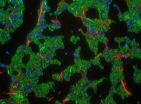By observing the sky as it is today, and peering back in time using the Hubble and Herschel telescopes, the team have shown that a large proportion of galaxies have undergone a major 'metamorphosis' since they were initially formed after the Big Bang.
By providing the first direct evidence of the extent of this transformation, the team hope to shed light on the processes that caused these dramatic changes, and therefore gain a greater understanding of the appearance and properties of the Universe as we know it today.
In their study, which has been published in the Monthly Notices of the Royal Astronomical Society¸ the researchers observed around 10,000 galaxies currently present in the Universe using a survey of the sky created by the Herschel ATLAS and GAMA projects. The researchers then classified the galaxies into the two main types: flat, rotating, disc-shaped galaxies (much like our own galaxy, the Milky Way); and large, oval-shaped galaxies with a swarm of disordered stars.
Using the Hubble and Herschel telescopes, the researchers then looked further out into the Universe, and thus further back in time, to observe the galaxies that formed shortly after the Big Bang. The researchers showed that 83 per cent of all the stars formed since the Big Bang were initially located in a disc-shaped galaxy. However, only 49 per cent of stars that exist in the Universe today are located in these disc-shaped galaxies--the remainder are located in oval-shaped galaxies.
The results suggest a massive transformation in which disc-shaped galaxies became oval-shaped galaxies.
A popular theory is that this transformation was caused by many cosmic catastrophes, in which two disk-dominated galaxies, straying too close to each other, were forced by gravity to merge into a single galaxy, with the merger destroying the disks and producing a huge pileup of stars. An opposing theory is that the transformation was a more gentle process, with stars formed in a disk gradually moving to the centre of a disk and producing a central pile-up of stars.
Lead author of the study Professor Steve Eales, from Cardiff University's School of Physics and Astronomy, said: "Many people have claimed before that this metamorphosis has occurred, but by combining Herschel and Hubble, we have for the first time been able to accurately measure the extent of this transformation.
"Galaxies are the basic building blocks of the Universe, so this metamorphosis really does represent one of the most significant changes in its appearance and properties in the last 8 billion years." Professor Asantha Cooray, a co-author of the study from the University of California, said: "This study is important as it establishes statistics showing that almost all stars formed in spiral galaxies in the past, but a large fraction of these now appear as large, dead, elliptical galaxies today. This study will require us to refine the models and computer simulations that attempt to explain how galaxies formed and behaved over the last 13 billion years."
Dr David Clements, a co-author of the study from Imperial College London, said: "Up to now we've seen individual cases in the local universe where galaxy collisions convert spirals into ellipticals. This study shows that this kind of transformation is not exceptional, but is part of the normal history of galaxy evolution."
Matthew Allen, a Ph.D. student at Cardiff University and a member of the team, said: "This is a huge step in understanding how the galactic population has evolved over billions of years. Using some of the most cutting edge data and techniques, we are finally beginning to understand the processes that have shaped our Universe."
INFORMATION:
Notes to editors
1. For further information contact:
Steve Eales -Lead author
Cardiff University
steve.a.eales@googlemail.com
Office +44(0)2920-876168; Mobile +44(0)7775871691
Michael Bishop
Communications & Marketing
Cardiff University
Tel: 02920 874499
Email: BishopM1@cardiff.ac.uk
Tomas Barrett
Communications & Marketing
Cardiff University
Tel: 02920 875596
Email: baretttl1@cardiff.ac.uk
2. Cardiff University is recognised in independent government assessments as one of Britain's leading teaching and research universities and is a member of the Russell Group of the UK's most research intensive universities. The 2014 Research Excellence Framework ranked the University 5th in the UK for research excellence. Among its academic staff are two Nobel Laureates, including the winner of the 2007 Nobel Prize for Medicine, University Chancellor Professor Sir Martin Evans. Founded by Royal Charter in 1883, today the University combines impressive modern facilities and a dynamic approach to teaching and research. The University's breadth of expertise encompasses: the College of Arts, Humanities and Social Sciences; the College of Biomedical and Life Sciences; and the College of Physical Sciences and Engineering, along with a longstanding commitment to lifelong learning. Cardiff's flagship Research Institutes are offering radical new approaches to pressing global problems. http://www.cardiff.ac.uk
3. The Herschel Space Observatory: The Herschel Space Observatory, launched in 2009, was the largest telescope ever sent into space, with a mirror almost twice the diameter of that of the Hubble Space Observatory. Herschel was sent to the second Lagrangian point, almost four times as far as the Moon, and observed the sky at far-infrared wavelengths for four years, until the liquid helium, which was used to cool the detectors ran out. Herschel provided the first look at the Universe in a range of wavelengths that are impossible to observe from the ground. The importance of the observatory lies in the fact that half the radiation from stars and galaxies is absorbed by interstellar dust, tiny solid fragments in interstellar space. By observing radiation from the obscuring dust, Herschel observations have made it possible to measure the amount of this missing radiation; and by combing Herschel and optical observations, it is possible for the first time to accurately measure the energy output of galaxies.
4. The Herschel ATLAS: The Herschel ATLAS was the largest survey carried out with Herschel. Jointly led by Loretta Dunne at the University of Canterbury (New Zealand) and Stephen Eales at Cardiff University, the Herschel ATLAS team consists of 160 scientists from 17 different countries. More information on the survey can be found at www.h-atlas.org.

